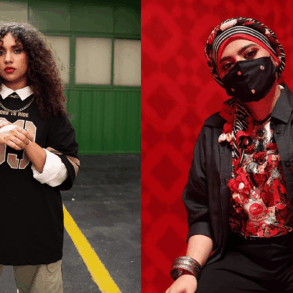The second in a series of five Retropolis stories looking back at moments in hip-hop history during the week of the music genre’s 50th anniversary.
In 1979, the Billboard charts were awash in disco grooves and New Wave when a single from a newly formed hip-hop group emerged with a bouncing bass line, infectious rhymes and indefatigable run time.
In hindsight, almost every aspect of “Rapper’s Delight” by the Sugarhill Gang appeared miscalibrated: Most members of the hastily formed group hailed from New Jersey rather than hip-hop’s home base of the Bronx, and they weren’t well-known in the local rap scene.
Driving them was a producer whose earlier label had been known for turning out trend-chasing novelty songs. The bass line was cribbed from a charting disco hit, while many of the song’s lyrics were lifted from another MC. The full-length version of the song clocked in at a whopping 14-plus minutes. The track was laid down in a single take.
When “Rapper’s Delight” by the Sugarhill Gang hit the airwaves in the summer of 1979, the mastermind producer behind it was merely expecting to cash in on a fad she saw bubbling up from the club scene in New York. Few expected the song to have real staying power. Instead, “Rapper’s Delight” become the massive hit, selling 14 million records and announcing hip-hop’s arrival to the mainstream.
“That was a monumental song, for everyone,” rap superstar Kurtis Blow told The Washington Post this summer. “I remember that summer of ’79, every car driving up the block, every bus, every train, every boombox, every radio station was playing that song.”
For Sugarhill Gang members Big Bank Hank, Wonder Mike and Master Gee, their whirlwind origin story started outside a New Jersey pizza parlor after Jersey-based producer Sylvia Robinson was struck by inspiration at a Harlem disco.
In 1979, the 43-year-old Robinson and her husband, Joe, were facing bankruptcy after the collapse of their label, All Platinum Records. But when her niece threw her a birthday party at the Harlem World nightclub, Robinson spotted an opportunity when she heard the DJ, Lovebug Starski, laying down rhymes and catchphrases as he spun dance tracks.
“As I was sitting there, the dee jay was playing music and talking over the music, and the kids were going crazy,” Robinson said in a 1997 interview with the Star-Ledger. “All of a sudden, something said to me, ‘Put something like that on a record, and it will be the biggest thing.’ I didn’t even know you called it rap.”
Before becoming one of the few female record producers and label owners at the time, Robinson had been a hitmaker in her own right, beginning in the 1950s as half of the duo Mickey and Sylvia. (Their hit single “Love Is Strange” was recognized by a new generation after being used in films such as “Dirty Dancing” and “Casino.”) She recruited her teenage son to help her tap into the rap talent in the area.
On a tip from her son, Robinson discovered Henry “Big Bank Hank” Jackson when he was rapping over tapes while working at the Crispy Crust pizza joint in Englewood. Robinson, who died in 2011, and Jackson, who died in 2014, recalled in past interviews how Jackson walked out of the restaurant in his flour-covered apron and auditioned for Robinson in the back of her son’s Oldsmobile 98.
As Robinson recalled to the Star-Ledger, Guy “Master Gee” O’Brien was walking by during Jackson’s audition and asked to try out as well. Later that day, an associate of Robinson and her son turned them on to Michael “Wonder Mike” Wright, an Englewood teenager who was teetering on the verge of homelessness. Wright auditioned at Robinson’s home that evening.
Before gathering the group and christening them the Sugarhill Gang — named after a wealthy neighborhood in Harlem — Robinson had recent signees to her nascent Sugarhill Records label, the funk group Positive Force, lay down a backing track. Realizing that rappers were used to laying down verses over familiar songs, she chose the riff from Chic’s “Good Times,” which had been in heavy rotation in the clubs and the airwaves that year.
There were chemistry, smooth vocals and an infectious beat, and it was laid down in a single take. Robinson recalls resisting the initial urge to trim the near-15-minute song down to a more radio-friendly length, and on Sept. 16, “Rapper’s Delight” was released.
The song soon began burning up the charts, hitting No. 4 on the Billboard Hot Soul Singles in December, and eventually peaking in January of 1980 at No. 36 on the Billboard Hot 100. It was the first time a rap song had crossed over to major mainstream success.
While the song ushered in a fervor for hip-hop, it was soon followed by other hits for Sugarhill Records, such as “The Message” by Grandmaster Flash and the Furious Five. It also served as a cautionary tale for the legal battles, exploitation by labels and questions over credit that have long loomed over hip-hop.
Nile Rodgers, the guitarist and co-founder of Chic has both praised and criticized “Rapper’s Delight,” which sampled his song “Good Times.” In a 2007 interview from Canadian Music Week, he recalled playing a show with the Clash and Blondie when an MC named Fab 5 Freddie ran onstage and started rapping as they played.
“It felt like poets doing what they did, in the same way if I jumped onstage with Prince and started playing guitar,” Rodgers said. “These guys jumped onstage with their rhymes and their styles and their stories … when we laid down that groove, it started going crazy.”
But months later while at a club, Rodgers heard a familiar bass line and Wonder Mike’s now-iconic opening.
I said-a hip, hop, the hippie, the hippie to the hip hip hop-a you don’t stop the rock-it t to the bang-bang boogie, say up jump the boogie to the rhythm of the boogie, the beat …
“I heard the strings from my record — which was an exact sample, before they had sampling,” Rodgers said. “I certainly didn’t mind people jamming to us onstage live, but to record it and not put our names on it and make a lot of money? I think the record ended up being even bigger than ‘Good Times.’ At least it was more exciting, because it felt like a new art form.”
Rodgers and Chic bassist Bernard Edwards threatened to sue, eventually settling and receiving songwriting credits on “Rapper’s Delight.”
Curtis Brown, better known as Grandmaster Caz or Casanova Fly, wasn’t so lucky. When “Rapper’s Delight” became a hit, Brown was working at Crispy Crust with Henry “Big Bank Hank” Jackson as his manager. Jackson asked Caz to write some rhymes for him, Brown told The Washington Post in 2016.
Those rhymes are featured prominently in “Rapper’s Delight,” for which Brown is not credited. Jackson even raps Brown’s name: “I’m the C-A-S-A-N, the O-V-A, and the rest is F-L-Y.”
The Sugarhill Gang went on to achieve modest success with “Apache” in 1982, but it only notched No. 53 on the Billboard Hot 100 and sold a fraction of what “Rapper’s Delight” had achieved.
In 2011, “Rapper’s Delight” was added to the Library of Congress for its cultural significance. The entry noted, “Although, it became famous on the back of serious claims of intellectual theft, ‘Rapper’s Delight’ has stood its ground and never crumbled over time. It is an invaluable requirement in the world of hip-hop, propelling rap music into what it is today.”
Keith McMillan contributed to this report.
This post was originally published on this site be sure to check out more of their content.






